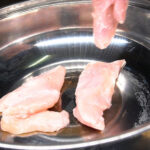Can Dogs Eat Raw Pork Bones
Bones are a popular treat for many dogs, but not all bones are safe or healthy for them to eat. Pork bones, in particular, have been controversial among dog owners and experts, as they can pose various risks and benefits depending on how they are prepared and consumed. In this article, we will explore the question “can dogs eat raw pork bones”, and provide some insights and tips for feeding your furry friend bones.
What are pork bones?
Pork bones refer to the skeletal parts of pigs, which are commonly used in human food production as well as pet food. Pork bones can be categorized into several types based on their size and shape, such as ribs, chops, femurs, knuckles, and necks. Some pork bones may still have meat attached to them, while others may be cleaned or cooked before being sold.
Are raw pork bones safe for dogs?
The short answer is no. Raw pork bones can contain harmful bacteria such as Salmonella and E. coli, which can cause food poisoning in both dogs and humans. Raw pork is also more likely to harbor parasites such as Trichinella spiralis, which can cause muscle pain, weakness, fever, and other symptoms in infected animals.
Moreover, raw pork bones can splinter or break easily when chewed by dogs, especially those who are aggressive chewers or have weak teeth. The sharp fragments can get stuck in a dog’s mouth, throat, stomach, or intestines, causing choking, bleeding, blockage, or even perforation of the digestive tract. The risk is higher if the bone is too small for the dog’s size or if the dog swallows it whole without chewing.
Therefore, it is generally not recommended to give raw pork bones to your dog as a treat or meal option. Instead, you should opt for safer alternatives that can still satisfy your dog’s chewing needs and nutritional requirements.
What are the alternatives to raw pork bones?
There are many types of bones and non-bone options that you can choose from to give your dog a healthy and enjoyable chewing experience. Some of the most popular options include:
– Raw beef or lamb bones: While not completely risk-free, raw beef or lamb bones are generally safer than pork bones as they have thicker and harder surfaces that are less likely to splinter or break. However, you should still supervise your dog when chewing on these bones and discard them if they become too small or damaged.
– Cooked bones: Cooked bones, whether from pork or other animals, are generally more brittle and prone to splintering than raw bones. Therefore, it is not recommended to feed your dog cooked bones as they can cause serious harm. The heat and pressure of cooking can also remove some of the nutrients and flavor from the bone, making it less appealing to dogs.
– Non-bone chews: If you prefer not to give your dog any type of bone, there are many non-bone chews available on the market that can offer similar benefits. These include antlers, horns, hooves, bully sticks, rawhide chews, and dental chews. However, you should be aware that some of these products may also pose risks such as choking, blockage, or dental damage if not used properly.
– Food puzzles: Food puzzles are another fun and stimulating way to engage your dog’s chewing behavior while providing mental stimulation and nutrition. You can stuff food or treats into various types of puzzle toys such as Kongs, balls, cubes, mats, or mazes, which your dog has to figure out how to access. This can help prevent boredom, anxiety, and destructive behavior in dogs who crave stimulation.
What are the benefits of giving dogs bones?
Despite the risks associated with certain types of bones, many dogs enjoy chewing on them and derive some health benefits from doing so. Chewing on bones can help:
– Clean teeth and freshen breath: The mechanical action of chewing on bones can help remove plaque, tartar, and food debris from a dog’s teeth, reducing the risk of dental disease and bad breath.
– Exercise jaw muscles: Chewing on bones can also strengthen a dog’s jaw muscles and improve their biting force, which can be useful for hunting, playing, or defending themselves.
– Provide nutrition: Bones contain various nutrients such as calcium, phosphorus, magnesium, and collagen, which can support bone health, skin and coat health, immune function, and joint mobility.
However, it is important to note that not all dogs may benefit from chewing on bones, especially those with underlying dental or digestive issues. Moreover, the nutritional value of bones may vary depending on the source and quality of the bone.
Conclusion
In conclusion, while dogs can technically eat raw pork bones, it is not recommended due to the potential risks of bacterial infection and choking hazards. Instead, you should consider safer alternatives such as raw beef or lamb bones, non-bone chews, food puzzles, or other types of treats that can satisfy your dog’s needs without compromising their health. As always, you should consult with your veterinarian if you have any concerns about your dog’s diet or behavior. And remember to have fun and enjoy the bonding experience with your furry friend!



